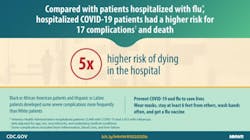Hospitalized patients five times more likely to die from COVID-19 than from the flu
Hospitalized patients with COVID-19 in the Veterans Health Administration (VHA) had a more than five times higher risk for in-hospital death and increased risk for 17 respiratory and non-respiratory complications than did hospitalized patients with influenza, according to a new report from the Centers for Disease and Prevention and Control (CDC).
Compared with influenza, COVID-19 is associated with increased risk for most respiratory and non-respiratory complications. Certain racial and ethnic minority groups are disproportionally affected by COVID-19. The risks for sepsis and respiratory, neurologic, and renal complications of COVID-19 were higher among non-Hispanic Black or African American and Hispanic patients than among non-Hispanic White patients.
COVID-19 is primarily a respiratory illness, although increasing evidence indicates that infection with SARS-CoV-2, the virus that causes COVID-19, can affect multiple organ systems. Data that examine all in-hospital complications of COVID-19 and that compare these complications with those associated with other viral respiratory pathogens, such as influenza, are lacking. To assess complications of COVID-19 and influenza, electronic health records (EHRs) from 3,948 hospitalized patients with COVID-19 (March 1–May 31, 2020) and 5,453 hospitalized patients with influenza (October 1, 2018–February 1, 2020) from the national Veterans Health Administration (VHA), the largest integrated healthcare system in the United States, were analyzed.
Findings from a large, national cohort of patients hospitalized within the VHA illustrate the increased risk for complications involving multiple organ systems among patients with COVID-19 compared with those with influenza, as well as racial/ethnic disparities in COVID-19–associated complications. Compared with patients with influenza, those with COVID-19 had a more than five times higher risk for in-hospital death and approximately double the ICU admission risk and hospital length of stay, and were at higher risk for 17 acute respiratory, cardiovascular, hematologic, neurologic, renal and other complications. Racial and ethnic disparities in the percentage of complications among patients with COVID-19 was found for respiratory, neurologic, and renal complications, as well as for sepsis.
Persons from racial and ethnic minority groups are increasingly recognized as having higher rates of COVID-19, associated hospitalizations, and increased risk for severe in-hospital outcomes. Although previous analysis of VHA data found no differences in COVID-19 mortality by race/ethnicity, in this analysis, Black, Hispanic, and non-Hispanic patients of other races had higher risks for sepsis and respiratory, neurologic, and renal complications than did White patients. The disparities in acute complications among racial and ethnic minority groups could not solely be accounted for by differences in underlying medical conditions or age and might be affected by social, environmental, economic, and structural inequities.
The risk for respiratory complications was high, consistent with current knowledge of SARS-CoV-2 and influenza pathogenesis. Notably, compared with patients with influenza, patients with COVID-19 had two times the risk for pneumonia, 1.7 times the risk for respiratory failure, 19 times the risk for ARDS, and 3.5 times the risk for pneumothorax, underscoring the severity of COVID-19 respiratory illness relative to that of influenza. Conversely, the risk for asthma and COPD exacerbations was approximately three times lower among patients with COVID-19 than among those with influenza.
The risk for certain acute non-respiratory complications was also high, including the risk for sepsis and renal and cardiovascular complications. Patients with COVID-19 were at increased risk for acute kidney failure requiring dialysis than were patients with influenza, consistent with previous evidence of influenza-and COVID-19–associated acute kidney failure.
The frequent occurrence and increased risk for sepsis among patients with COVID-19 is consistent with reports of dysregulated immune response in these patients. The distribution of cardiovascular complications differed between patients with influenza and those with COVID-19; patients with COVID-19 experienced lower risk for acute MI, unstable angina, and acute CHF but higher risk for acute myocarditis and cardiogenic shock. There were no significant differences in occurrence of acute MI, unstable angina, and CHF among patients with COVID-19 or influenza diagnosed during the same months, suggesting potential confounding by seasonal variations in cardiovascular disease.
Other less common (<10 percent), but often severe complications included hematologic and neurologic complications, bacteremia, and pressure ulcers. Whereas other viruses, like influenza, might cause proinflammatory cytokines and clot formation, the findings from this study suggest that hematologic complications are a much more frequent complication of COVID-19, consistent with previous reports of COVID-19–related thromboembolic events.
Patients with COVID-19 might be at increased risk for pressure ulcers related to prolonged hospitalizations, prone positioning, or both.
Hospitalized adult VHA patients with COVID-19 experienced a higher risk for respiratory and non-respiratory complications and death than did hospitalized patients with influenza. Disparities by race/ethnicity in experiencing sepsis and respiratory, neurologic, and renal complications, even after adjustment for age and underlying medical conditions, provide further evidence that racial and ethnic minority groups are disproportionally affected by COVID-19. Clinicians should be vigilant for symptoms and signs of a spectrum of complications among hospitalized patients with COVID-19 so that interventions can be instituted to improve outcomes and reduce long-term disability.
